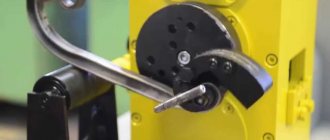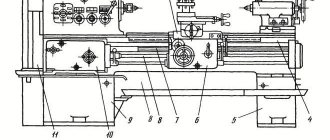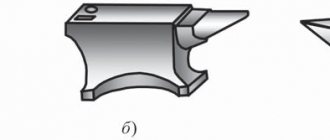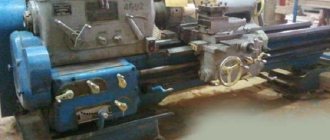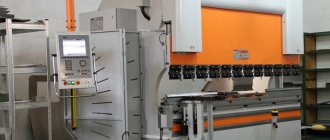There are various devices for changing the shape and characteristics of the material. Forged products look relevant at any time. To perform forging, you need to use special equipment. You can buy artistic forging machines at a hardware store or make your own. It is important to understand forging technologies.
Artistic forging machine
Forging process
Processing of metal blanks can be divided into two groups:
- Cold method - changing the shape of the workpiece using special equipment. Machines are based on the use of levers that increase force and transfer it to the material. Does not require additional arrangement of the workshop, creation of a forge, or purchase of fuel for it. Metal products are connected using welding machines.
- The hot method is a technological process in which the material is heated to a certain temperature. After heating, the metal becomes more ductile and less effort needs to be used to change the shape of the workpiece.
Cold forging of metal is a simple processing method. The hot method requires practical experience from the blacksmith. However, when heating the workpieces, it is possible to produce products of different shapes and change the technical characteristics of the material.
We will advise you on any questions!
Machines for performing forging and stamping operations (or rather, because some equipment is usually created for the developed technology, and not vice versa) are a common type of device for metalworking.
For example, in machine- and instrument-making enterprises or factories for the production of metal structures, for every 5 metal-cutting machines there is necessarily one piece of equipment for pressure processing. And not only metals: for example, the same PET bottles are produced on injection molding machines, which are also specialized stamping equipment.
Tools and equipment
Depending on which forging technology is selected, the list of equipment used changes. Machines for artistic forging:
- press;
- twister;
- snail;
- flashlight;
- globe;
- gnutik;
- wave.
This equipment is used when applying the cold processing method. When hot processing, the main devices and tools are:
- bugle;
- anvil;
- blacksmith hammer;
- forceps;
- hammers for artistic processing.
We must not forget about fuel for the forge. When heating metal, you need to take care of fire safety and good ventilation. A fire extinguisher must be present in the workshop, and you must work using protective equipment to avoid burns.
Evolution of equipment development
Until the 15th and 16th centuries, almost all metal products were produced by private workshops and small workshops. However, the beginning of the Great Geographical Discoveries with the accompanying increase in the tonnage of sea vessels required the production of fairly large anchors and other ship equipment. It was no longer possible to forge such large parts by hand with a hammer. As a result, the first mechanical hammers powered by water power appeared.
Further, the impetus was the development of weapons and vehicles, and in the 19th century entire metalworking giants with steam equipment emerged.
The invention of hydraulic presses made it possible to introduce stamping as the main technology for mass production of products. And the further emergence of electric motors gave impetus to the development of crank presses, which form the modern basis of forging and stamping equipment.
Hot Forging Equipment
When hot forging metal, you need to heat the workpiece to the required temperature (the indicator depends on the material used). Among the necessary tools and devices, three types of equipment can be distinguished, which need to be discussed separately.
Forge
This is a device for heating the material being processed. The forge consists of several key elements:
- The hearth is a container for storing fuel, equipped with a grate.
- A working window through which workpieces are placed.
- Chimney for removing combustion products.
- Air supply holes for uniform combustion of consumables.
In order not to spoil the material and to make the heat treatment process more efficient, you need to use high-quality fuel to light the forge. It is better to choose coke coal.
Muffle furnace
To heat a metal billet to a high temperature, muffle furnaces are used. The difference from the forge is the presence of a muffle. It does not allow the heated part to come into contact with fuel or heating elements.
Muffle furnace
Anvil
Key equipment in a forge shop for hot forging. The anvil is a heavy cast element that consists of several parts:
- Horns that bend heated metal.
- Platband.
- Base with feet for stable placement on the workshop floor.
Anvils are manufactured according to GOST standards. The weight of the forging device can reach 270 kg.
Overview of IPONMAC presses and their characteristics
| Model series | KD 23D | HL41 | PG41 |
| Nominal force, t | 10-80 | 40-315 | 40-315 |
| Opening height/clearance, mm | 130-280 | 800-1600 | 800-1600 |
| Table/bottom plate size, mm | up to 520*860 | up to 1400*1200 | up to 1400*1200 |
| Drive power, kW | 1,1-7,5 | 5,5-30 | 5,5-30 |
| Weight, kg | 600-5280 | 3000-36000 | 3-36000 |
Cold forging machines
Forging equipment for cold forging is much more diverse than for the hot method of working with metals. This is due to the fact that cold metal is harder to work with. Various technological operations are performed using separate devices. Metal structures are assembled from individual elements, which are fastened together with a welding machine. We need to talk about certain types of devices for cold forging, with the help of which the desired shape of workpieces is obtained.
Snail machine
A device with a cast base and curved elements attached to it. The workpiece is slowly fed through the inlet. The base begins to twist and the shape of the metal part changes.
Press machine
Using a hand cutter, rods and fittings are compressed. This device is a manual roller, which consists of 2 shafts, gears, a base with a holding structure, and a handle for rotation.
Torsion bar machine
A torsion bar allows you to twist a metal rod into a spiral or combine several reinforcements together. A torsion bar machine consists of a base, a fixed vice, and a rotating clamp. When it rotates, the metal rod twists along the longitudinal axis.
Gnitik machine
A bender is a hand-held device for bending metal rods at different angles. The design of the machine is a cast base on which two rotating shafts are fixed. Between them there is a movable diamond-shaped element, during the movement of which the workpiece is bent at the desired angle.
Wave machine
Using a wave, you can make forged products with a wavy shape. Consists of two metal disks, a working surface, and a gate for rotating moving elements. To change the waveform, you need to change the position of the disks on the desktop.
Wave machine
Types of stamping equipment
To produce products from sheet metal, presses equipped with various stamps are used. During operation of the equipment, the upper component of the die moves, the lower part remains stationary.
Deformation of the workpiece occurs at the moment of contact between parts of the equipment. There are various models of stamping presses, which allows you to choose the right machine to produce the required parts.
Hydraulic Punching Machine
Presses for metal stamping are:
- crank type;
- hydraulic;
- radial forging type;
- electromagnetic type.
Crank presses are a simple type of equipment and can be double or triple acting. The presses got their name from the crank mechanism, which is the main structural element of the machine. The principle of operation of the mechanism is based on the transformation of rotational motion from the drive into reciprocating periodic movement of the press element - the slide.
DIY cold forging machines
DIY cold forging machines are popular in private workshops and garages. Blacksmiths make their own tools for metal processing so as not to waste money. Stages of creating manual equipment:
- Initially, you need to select the type of machine to be manufactured. The snail should have a fixed spiral on the working surface, a homemade bend, fixed shafts and a central movable element, a torsion bar, two types of clamps, one of which is movable.
- Draw a drawing of the future device on paper. Indicate the exact dimensions, moving and fastening elements.
- Make a work surface on which the remaining elements will be located.
After preparing the drawing, you need to collect tools and consumables. These include:
- Plate steel for creating a frame, working surface, and body of a handheld device.
- Fastening elements - nuts, bolts.
- Bulgarian.
- Metal bending tool.
- Welding machine.
- Sander.
- Pliers.
- Drill with a drill bit for metal.
- Marking tool.
Depending on what type of forging machine is chosen, you may need shafts, bushings, gears, metal disks, angles, channels, vices, gates, handles.
To change the shape of metal workpieces, equipment must be made of metals with a high strength index. First you need to prepare all the elements of the future device separately. Next you need to connect them using a welding machine. Sand the connecting seams and coat them with a protective anti-corrosion compound.
Additionally, it is necessary to prepare the workplace, think about where the forge vice will be located.
Select an area for connecting individual elements of the product being manufactured. Wear gloves when working with metal sheets. Weld elements using a protective mask. Before work, check the reliability of fastening of the elements. You can buy artistic forging machines or make them yourself. With independent production, it is easier to establish the process of processing cold metal. This is due to the fact that the hot method requires good ventilation. It is easy to burn yourself with heated metal and it is more difficult to work with.
Features of open and closed dies
Closed stamping
Stamping equipment can be equipped with open or closed dies. In an open die, excess metal flows into a burr or flash that performs a specific function. The main disadvantages of this technology are: loss of alloy due to flash, reduction in product quality due to cut fibers when removing burrs.
Closed dies are used to produce simple shaped products. This flash-free technology is characterized by metal savings, no costs for cutting burrs, and high product quality due to all-round compression. Metal fibers are not cut. The closed die processing method is used for low-plasticity alloys. The main disadvantages are: the need for precise dosage of the alloy, the complex design of the die.
In modern manufacturing, stamping is primarily a preparatory operation that allows the production of parts for both electronics and aircraft or watercraft. The resulting products are subsequently subjected to welding, cutting, riveting and other processing methods depending on the technological process.
Air driven forging hammer
A pneumatic press is an efficient, but at the same time affordable forging equipment, which is also distinguished by its compact dimensions. This machine operates using the energy of compressed air, which is supplied to the mechanisms by a built-in compressor. The operation of the compressor, the pistons of which, moving in its main cylinder, create an air flow with the required pressure, is ensured by a drive electric motor.
Since the impact mechanism of a pneumatic forging machine is operated by a crank, its design resembles that of a crank press. Before starting such equipment, the compressor and working pistons in the master cylinder are in their highest and lowest positions. When the machine is put into operation, the pistons begin to move towards each other, compressing the air between them, the pressure of which is transmitted to the crank, directly connected to the striker. For one blow of the working part of the hammer of a pneumatic machine there is one revolution of the crank mechanism. Accordingly, in order for the hammer to act on the workpiece at a higher frequency, it is necessary to ensure more intensive operation of the compressor. Even despite its small dimensions, a pneumatic press can provide a hammer impact weight of up to 1 ton.
Pneumatic forging hammer MA-4129 is designed for hot stamping in open dies
A steam-air hammer operates on a principle similar to a pneumatic press, in which the impact energy is provided by hot steam supplied directly from the boiler or through a special compressor. The mass of impacts that such equipment allows to achieve can reach up to 8 tons, and the speed of their application is 50 m/sec. Depending on the model, it can work in automatic mode, when blows are applied to the part continuously, or in manual mode, when the corresponding button or pedal must be pressed to activate the striker.
Mechanical hammers can be used for:
- free forging or forging operations in which a mold is used to form the finished product;
- stamping operations with sheet metal parts - cutting along a straight or curved line, cutting along various contours, punching holes (punching press), etc.;
- punches - making products using a special template.
